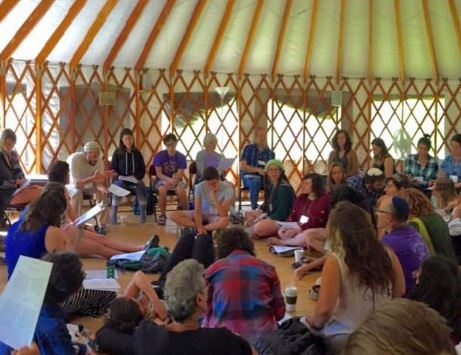The Benefits of Making Field Building a Team Sport
December 6th, 2016
 This past summer, at the first ever Jewish Outdoor, Food, Farming, and Environmental Education (JOFEE) gathering at Isabella Freedman Retreat Center, a group of practitioners and foundation professionals came together around the shared purpose of building the field.
This past summer, at the first ever Jewish Outdoor, Food, Farming, and Environmental Education (JOFEE) gathering at Isabella Freedman Retreat Center, a group of practitioners and foundation professionals came together around the shared purpose of building the field.
The Jim Joseph Foundation already shared some of the innovative learning and professional development that occurred, which certainly will help the field grow and mature. But another aspect of this gathering warrants an examination, because while at face value this type of gathering is not unique, a gathering that included such diverse funders is. Moreover, we were not there merely as listeners or as observers of a conference, our group of funders joined with practitioners for focused and deliberate visioning and networking conversations.

The gathering included the Jim Joseph Foundation and representatives from the Atlanta Jewish Federation, Emanuel J. Friedman Philanthropies, Gendler Grapevine, the Leichtag Foundation, the Lucious Littauer Foundation, Hazon, Pearlstone Center, Urban Adamah, and Wilderness Torah. Just as each practitioner represented a different organization in this space—all of which complimented each other while not entirely duplicating efforts—each of the funders had a unique justification for its funding in this space. So how did we all end up there together?
Inherently, while all the organizations at that first meeting to some degree address farming, food justice, the environment, and other kinds of Jewish outdoor educational interventions, there are important strategic differences to recognize. Whereas the Emanuel J. Friedman Philanthropies (founders of Jewish Initiative for Animals) and the Leichtag Foundation (founders of the Coastal Roots Farm) see JOFEE funding as a way of furthering combined environmental, humanistic, and Jewish educational missions, for example, the Jim Joseph Foundation sees this investment primarily as a means to funding its strategic priorities of educating Jewish educators and expanding opportunities for effective Jewish learning.
By making space for funders with different strategies and missions to come together, the field displayed a strength (and a potential for even greater impact) only possible by bringing together all of the issue areas of JOFEE. There are many benefits from this collaboration, and important lessons:
As the Jim Joseph Foundation has discussed, collaboration comes with real challenges. Yet time and again we see that the benefits—creative initiatives, greater reach, more opportunities to scale and to become sustainable—outweigh these challenges. A single funder has a ceiling on the amount of long-term success it achieves on its own. I am grateful to have been included in this initial gathering on behalf of the Jim Joseph Foundation, and to Hazon for assembling this group. The field is stronger as a result.